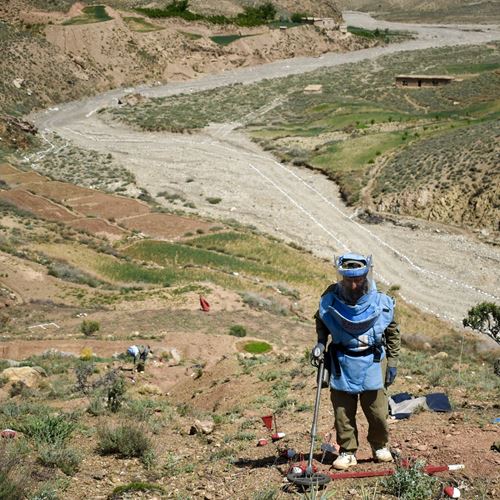New and old explosive ordnance are literally littered across Afghanistan – a country that has suffered through decades of continuous armed conflicts leaving behind lethal traces. The hazards are not only posing risk to civilian lives, but also livelihoods at a time when Afghans are suffering from deep poverty and the worst food insecurity crisis in recent years.
Though active fighting across much of the country has ceased, the legacy of battlefields are still there. Along with them are mines and unexploded ordnance – a visible reminder of war, but often out of sight and hidden underground.
These remnants of war witness of conflicts in Afghanistan over time, many of them dating back to the late seventies when the decade-long Soviet occupation started, followed only a few years later by the civil war in the mid-nineties. The past nearly 20 years of intense fighting has displaced millions of people, left many more explosives on productive land, and hampered clearance efforts.
Unique opportunity to expand clearance efforts
Following the political takeover by the Islamic Emirate of Afghanistan (IEA) in August 2021, armed fighting has ceased in most parts of the country for the first time in decades. As a result, DRC and other humanitarian actors now have greater access to communities and explosive ordnance contaminated sites than ever before. This represents a unique window of opportunity to expand and invest in clearance efforts rapidly and significantly – including into areas that have seen little to no Humanitarian Mine Action responses in the past.
With the financial support of the Danish International Development Agency (DANIDA), DRC is continuing to clear and release high priority farmland to vulnerable communities among other places in Kabul and Logar provinces. This takes place through surveying, providing explosive ordnance disposal spot tasks, actual clearance, and risk awareness. As a result, people are provided with immediate improved physical safety while also freeing productive land for livelihood opportunities.
Economic recovery improves farming in Afghanistan
In other nearby areas, DRC’s efforts to improve livelihoods and build self-reliance are picking up new momentum. Support to economic recovery is scaled up with cash-for-work interventions such as the restoration of irrigation canals. Recreating access to irrigation is critical to help pave the way for better conditions for Afghans relying on farming to feed their families in the coming season.
